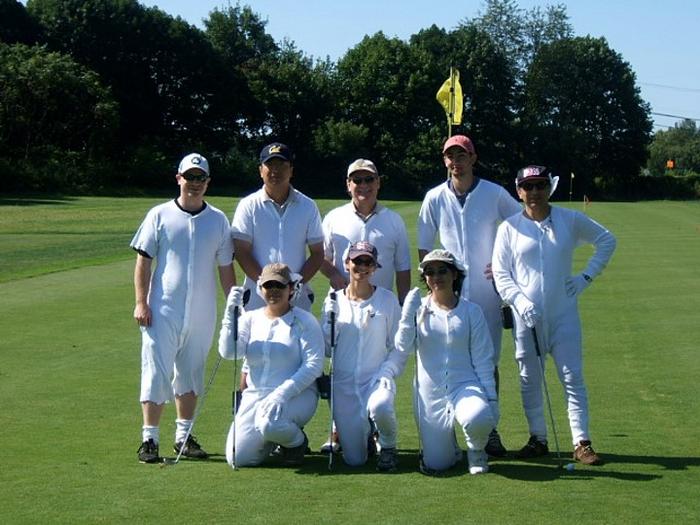For many, spring heralds fresh air and exercise on the golf course. But do players risk exposure to unsafe levels of pesticides used to beautify and maintain a golf course’s green grass? To find out, researchers asked volunteers to play 18 holes on a simulated course sprayed with common pesticides. They report the results in ACS Agricultural Science & Technology, saying there is likely limited cause for concern over toxic exposure from pesticide-treated turf.

Credit: John M. Clark
For many, spring heralds fresh air and exercise on the golf course. But do players risk exposure to unsafe levels of pesticides used to beautify and maintain a golf course’s green grass? To find out, researchers asked volunteers to play 18 holes on a simulated course sprayed with common pesticides. They report the results in ACS Agricultural Science & Technology, saying there is likely limited cause for concern over toxic exposure from pesticide-treated turf.
There are plenty of studies on pesticide exposure among people who tend and harvest crops grown in treated environments. But John M. Clark and colleagues couldn’t find much comparable information about individuals who play sports, including soccer and golf, in the great outdoors. So, his team designed a study to investigate golfers’ potential risks from four pesticides, which have low volatilities and relatively low toxicities for humans, and are commonly used on golf course turfgrass: cyfluthrin (insecticide), chlorothalonil (fungicide), MCPP-p (herbicide) and 2,4-D (herbicide).
For the study, the researchers created what they deemed a “worst-case-scenario” 18-hole course: All areas of a simulated golf course were treated with the manufacturers’ suggested maximum amount of all four pesticides. Then they recruited eight volunteer golfers to play a full round on the treated turf one hour after pesticide application and to remain on the course for four hours. To measure pesticide exposure, four of the volunteers wore cotton full-body suits with veils, socks and gloves that would pick up contact residues and personal air samplers that would capture airborne residues. The other four volunteers wore cut-off cotton suits over their own golfing clothes and submitted urine samples after the round.
After the volunteers finished golfing, Clark’s team measured pesticide residues on the dosimetry suits and air samplers and found that the hand and lower leg segments picked up the most residue while airborne residues contributed little to exposure. The researchers also measured the volunteers’ exposure risk from the levels of pesticides found on the suits and in the urine samples by calculating the hazard quotient (HQ). The team found that the HQ values from the golfers’ exposure indicated little risk to the four pesticides used in this study.
Finally, Clark and colleagues compared the insecticide cyfluthrin results to their 2008 Journal of Agricultural and Food Chemistry study with older, neurotoxic insecticides at the same simulated golf course site — and using the same protocols. Both studies’ HQ values were well below 1.0, the level that indicates potentially unsafe exposure. However, in the prior work, the volunteers’ urinalysis HQ values of 0.0318 and 0.054 for chlorpyrifos and carbaryl, respectively, were an order of magnitude greater than the volunteers’ urinalysis HQ of 0.0043 from this 2024 study with the insecticide cyfluthrin. The researchers say this comparison shows the potential benefit of using modern, lower volatility and less toxic pesticides, which could further reduce golfers’ risk of adverse effects from exposure.
The authors acknowledge funding from the United States Golf Association and the New England Regional Turf Foundation.
###
The American Chemical Society (ACS) is a nonprofit organization chartered by the U.S. Congress. ACS’ mission is to advance the broader chemistry enterprise and its practitioners for the benefit of Earth and all its people. The Society is a global leader in promoting excellence in science education and providing access to chemistry-related information and research through its multiple research solutions, peer-reviewed journals, scientific conferences, eBooks and weekly news periodical Chemical & Engineering News. ACS journals are among the most cited, most trusted and most read within the scientific literature; however, ACS itself does not conduct chemical research. As a leader in scientific information solutions, its CAS division partners with global innovators to accelerate breakthroughs by curating, connecting and analyzing the world’s scientific knowledge. ACS’ main offices are in Washington, D.C., and Columbus, Ohio.
To automatically receive news releases from the American Chemical Society, contact [email protected].
Note: ACS does not conduct research, but publishes and publicizes peer-reviewed scientific studies.
Follow us: X, formerly Twitter | Facebook | LinkedIn | Instagram
Journal
ACS Agricultural Science & Technology
DOI
10.1021/acsagscitech.3c00419
Article Title
“Golfer Exposure to Traditional Pesticides Following Application to Turfgrass”
Article Publication Date
14-Mar-2024




